Recycling of Raft-associated prohormone sorting receptor carboxypeptidase E requires interaction with ARF6
- PMID: 12960436
- PMCID: PMC266764
- DOI: 10.1091/mbc.e02-11-0758
Recycling of Raft-associated prohormone sorting receptor carboxypeptidase E requires interaction with ARF6
Abstract
Little is known about the molecular mechanism of recycling of intracellular receptors and lipid raft-associated proteins. Here, we have investigated the recycling pathway and internalization mechanism of a transmembrane, lipid raft-associated intracellular prohormone sorting receptor, carboxypeptidase E (CPE). CPE is found in the trans-Golgi network (TGN) and secretory granules of (neuro)endocrine cells. An extracellular domain of the IL2 receptor alpha-subunit (Tac) fused to the transmembrane domain and cytoplasmic tail of CPE (Tac-CPE25) was used as a marker to track recycling of CPE. We show in (neuro)endocrine cells, that upon stimulated secretory granule exocytosis, raft-associated Tac-CPE25 was rapidly internalized from the plasma membrane in a clathrin-independent manner into early endosomes and then transported through the endocytic recycling compartment to the TGN. A yeast two-hybrid screen and in vitro binding assay identified the CPE cytoplasmic tail sequence S472ETLNF477 as an interactor with active small GTPase ADP-ribosylation factor (ARF) 6, but not ARF1. Expression of a dominant negative, inactive ARF6 mutant blocked this recycling. Mutation of residues S472 or E473 to A in the cytoplasmic tail of CPE obliterated its binding to ARF6, and internalization from the plasma membrane of Tac-CPE25 mutated at S472 or E473 was significantly reduced. Thus, CPE recycles back to the TGN by a novel mechanism requiring ARF6 interaction and activity.
Figures
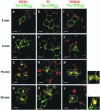
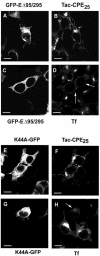
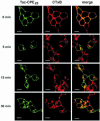
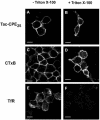
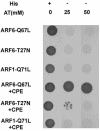




Similar articles
-
Sorting of carboxypeptidase E to the regulated secretory pathway requires interaction of its transmembrane domain with lipid rafts.Biochem J. 2003 Feb 1;369(Pt 3):453-60. doi: 10.1042/BJ20020827. Biochem J. 2003. PMID: 12403651 Free PMC article.
-
ARF1 and ARF4 regulate recycling endosomal morphology and retrograde transport from endosomes to the Golgi apparatus.Mol Biol Cell. 2013 Aug;24(16):2570-81. doi: 10.1091/mbc.E13-04-0197. Epub 2013 Jun 19. Mol Biol Cell. 2013. PMID: 23783033 Free PMC article.
-
GGA proteins associate with Golgi membranes through interaction between their GGAH domains and ADP-ribosylation factors.Biochem J. 2002 Jul 15;365(Pt 2):369-78. doi: 10.1042/BJ20020428. Biochem J. 2002. PMID: 11950392 Free PMC article.
-
Multiple pathways of exocytosis, endocytosis, and membrane recycling: validation of a Golgi route.Fed Proc. 1983 May 15;42(8):2407-13. Fed Proc. 1983. PMID: 6404654 Review.
-
Endocytosis of gene delivery vectors: from clathrin-dependent to lipid raft-mediated endocytosis.Mol Ther. 2013 Jun;21(6):1118-30. doi: 10.1038/mt.2013.54. Epub 2013 Apr 16. Mol Ther. 2013. PMID: 23587924 Free PMC article. Review.
Cited by
-
Clathrin-independent endocytosis: a unique platform for cell signaling and PM remodeling.Cell Signal. 2009 Jan;21(1):1-6. doi: 10.1016/j.cellsig.2008.06.020. Epub 2008 Jul 3. Cell Signal. 2009. PMID: 18647649 Free PMC article. Review.
-
Membrane-bound carboxypeptidase E facilitates the entry of eosinophil cationic protein into neuroendocrine cells.Biochem J. 2004 Sep 15;382(Pt 3):841-8. doi: 10.1042/BJ20040894. Biochem J. 2004. PMID: 15233624 Free PMC article.
-
New roles of carboxypeptidase E in endocrine and neural function and cancer.Endocr Rev. 2012 Apr;33(2):216-53. doi: 10.1210/er.2011-1039. Epub 2012 Mar 7. Endocr Rev. 2012. PMID: 22402194 Free PMC article. Review.
-
Pathways of clathrin-independent endocytosis.Nat Rev Mol Cell Biol. 2007 Aug;8(8):603-12. doi: 10.1038/nrm2216. Nat Rev Mol Cell Biol. 2007. PMID: 17609668 Free PMC article. Review.
-
Distinct endocytic mechanisms of CD22 (Siglec-2) and Siglec-F reflect roles in cell signaling and innate immunity.Mol Cell Biol. 2007 Aug;27(16):5699-710. doi: 10.1128/MCB.00383-07. Epub 2007 Jun 11. Mol Cell Biol. 2007. PMID: 17562860 Free PMC article.
References
-
- Bamezai, A., Goldmacher, V.S., and Rock, K.L. (1992). Internalization of glycosyl-phosphatidylinositol (GPI)-anchored lymphocyte proteins. II. GPI-anchored and transmembrane molecules internalize through distinct pathways. Eur. J. Immunol. 22, 15-21. - PubMed
-
- Benmerah, A., Bayrou, M., Cerf-Bensussan, N., and Dautry-Varsat, A. (1999). Inhibition of clathrin-coated pit assembly by an Eps15 mutant. J. Cell Sci. 112, 1303-1311. - PubMed
MeSH terms
Substances
LinkOut - more resources
Full Text Sources
Other Literature Sources
Research Materials
Miscellaneous

